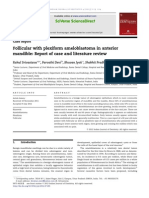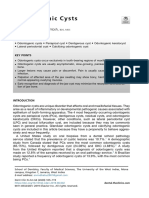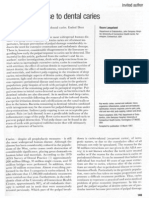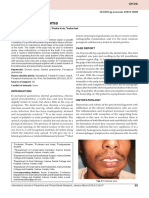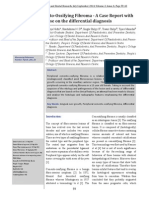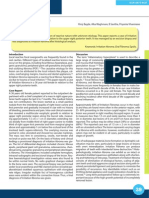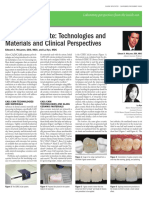Radicular Cyst: A Case Report: Harshitha KR, Varsha VK, Deepa. C
Radicular Cyst: A Case Report: Harshitha KR, Varsha VK, Deepa. C
Uploaded by
Ezza RiezaCopyright:
Available Formats
Radicular Cyst: A Case Report: Harshitha KR, Varsha VK, Deepa. C
Radicular Cyst: A Case Report: Harshitha KR, Varsha VK, Deepa. C
Uploaded by
Ezza RiezaOriginal Title
Copyright
Available Formats
Share this document
Did you find this document useful?
Is this content inappropriate?
Copyright:
Available Formats
Radicular Cyst: A Case Report: Harshitha KR, Varsha VK, Deepa. C
Radicular Cyst: A Case Report: Harshitha KR, Varsha VK, Deepa. C
Uploaded by
Ezza RiezaCopyright:
Available Formats
International Journal of Applied Dental Sciences 2015; 1(4): 20-22
ISSN Print: 2394-7489
ISSN Online: 2394-7497
IJADS 2015; 1(4): 20-22
2015 IJADS
www.oraljournal.com
Received: 17-05-2015
Accepted: 20-06-2015
Harshitha KR
Assistant professor Department
of dentistry, R.L.Jalappa
hospital & Research centre,
Tamaka, Kolar, Karnataka,
India.
Varsha VK
Senior lecturer, Department of
oral pathology, Rajarajeshwari
dental college, Bangalore,
Karnataka, India.
Deepa. C
Assistant professor Department
of dentistry, R.L.Jalappa
hospital & Research centre,
Tamaka, Kolar, Karnataka.,
India.
Correspondence
Harshitha KR
D/O K.M.Ramakrishna, #1491,
Kuruberpet, Kolar-563101,
Karnataka, India.
Radicular cyst: A case report
Harshitha KR, Varsha VK, Deepa. C
Abstract
Radicular cysts are common odontogenic cyst. It involves the apex of carious tooth. It is a true cyst, since
the lesion consists of pathologic cavity lined by epithelium and is often fluid filled. Radicular cyst which
remains after or develops subsequent to extraction is termed residual cyst. Cyst can be managed
surgically and or non-surgically. Choice of treatment depends on site and size of cyst. The present case, a
characteristic radicular cyst, was successfully managed with root canal therapy (RCT) along with surgical
enucleation.
Keywords: Odontogenic cyst, radicular cyst, RCT, enucleation.
1. Introduction
Cyst is defined as a pathologic epithelium lined cavity usually containing fluid or semi-solid
material. Odontogenic cysts are derived from the epithelium associated with the development
of dental apparatus. Several types of cyst may occur depending on the stage of odontogenesis
during which they originate. Odontogenic cysts are derived from 1) Tooth germ 2) Epithelial
rests of malassez 3) Reduced enamel epithelium of a tooth crown 4) Remnants of dental
lamina or 5) possibly the basal layer of oral epithelium. [1].
Radicular cyst is the most common odontogenic cyst. In contrast to other type of cysts, it
involves the apex of erupted tooth and sequel of periapical granuloma originating as a result of
bacterial infection and necrosis of the dental pulp, nearly always following carious
involvement of tooth. The epithelium is derived from epithelial rests of malassez in the
periodontal ligament, which proliferate as a result of inflammatory stimulus in a pre-existing
granuloma. Epithelium may be derived in some case from 1) Respiratory epithelium from
maxillary sinus when the periapical communicates with the maxillary sinus 2) Oral epithelium
from a fistulous tract 3) Oral epithelium proliferating apically from a periodontal pocket.(1)
Here is one such case of radicular cyst that presented as palatal swelling which was well
managed through surgical and non-surgical approach.
2. Case report
60 year male old patient reported to our department with swelling in anterior palate from past 6
months, which slowly increased to present size. On clinical examination a swelling measuring
about 2 x 3 cms extending from 21-24 in anterior palate, soft in consistency, attrition and
erosion present in 11,21,22 (Fig 1). No discharge noted. Teeth were tender on percussion.
Maxillary occlusal view radiograph was taken that showed well defined radiolucency
measuring approximately 2 x 4 cms involving apex of 11, 21 and 22 (Fig 2).
In the present case a definitive diagnosis of cyst was made i.r.t 11, 21, 22 on radiographic
examination but the final call for type of cyst was left to histopathologic report. Treatment plan
comprised of RCT and cyst enucleation for which consent was taken from the patient. RCT
was carried up till biomechanical preparation and remaining stages of RCT carried out
following surgical cyst enucleation as there was continuous drainage from the canal of infected
teeth and the chances of recurrence are more if the cysts remnants remained.
Cyst enucleation procedure: Lignocaine with 2% adrenaline injected to anaesthetize the
operating site. Crevicular incision was placed on palatal aspect extending from 14-24 to reflect
full thickness flap that exposed a wide palatal bone defect (fig 3). Cyst lining excavated along
with its content, which left a large gaping palatal bone defect measuring about 2 by 3 cms (fig
4). Thorough curettage done. Flap closure done with 3-0 silk suture. Specimen sent for
histopathological examination which confirmed radicular cyst (Fig 5).
~20~
International Journal of Applied Dental Sciences
Fig 1: preoperative photograph showing swelling
in anterior palate.
Fig 5: Histopathology picture.
Serous drainage from the canals continued for 15 days post
surgically. Once the canals were dry, obturation (filling) was
done and crowns were inserted in a weeks duration for the
anterior teeth11, 21, 22.
Fig 2: Occlusal view radiograph showing radiolucecy
involving apex of 11, 21 and 22.
Fig 3: Reflected full thickness flap showing wide
palatal defect.
Fig 4: Palatal bone defect after enucleation.
3. Discussion
Radicular cyst also known as periapical cyst, periodontal cyst,
root end cyst or dental cyst, originates from epithelial cell rests
of malassez in periodontal ligament as a result of inflammation
due to pulp necrosis or trauma. Radicular cysts, with an
incidence of 0.5-3.3% of the total number in both primary and
permanent dentition [2]. Occur more commonly between third
and fifth decades, more common in males than in females, and
more frequently found in the anterior maxilla than other parts
of oral cavity [3]. That can be characteristically appreciated in
the present case.
Pathogenesis of radicular cysts has been described as
comprising of three distinct phases: the phase of initiation, the
phase of formation and the phase of enlargement [4]. Radicular
cysts are usually asymptomatic and are left unnoticed, until
detected by routine radiographic examination where as some
long standing cases may undergo an acute exacerbation of the
cystic lesion and develops signs and symptoms such as
swelling, tooth mobility and displacement of unerupted tooth
[5]
. Associated teeth are always non-vital and may show
discoloration [6]. It clinically exhibits as buccal or palatal
swelling in maxilla, where as in mandible it is usually buccal
and rarely lingual. At first, the enlargement is bony hard but as
the cyst increases in size, bony covering becomes very thin
and the swelling exhibits springiness and becomes fluctuant
when the cyst has completely eroded the bone as seen in
present case [7].
Radiographically most radicular cyst appear as round or pear
shaped radiolucent lesion in the periapical region [8]. Greater
likelihood of radiolucencies being radicular cysts rather than
chronic periapical periodontitis lesions with increased size of
radiolucencies, particularly those over 2cm [9].
The choice of treatment may be determined by some factors
such as extension of the lesion, relation with noble structures,
evolution, origin, clinical characteristics of the lesion, cooperation and systemic condition of the patient. Treatment
options for radicular cysts can be conventional nonsurgical
RCT when lesion is localized or surgical treatment like
enucleation, marsupialization or decompression when the
lesion is large [10]. This case report presents successful surgical
enucleation of large radicular cyst alongside with root canal
treatment.
~21~
International Journal of Applied Dental Sciences
Histological features: Almost all radicular cysts are lined
wholly or partly by nonkeratinized stratified squamous
epithelium. This lining may be discontinuous ranging in
thickness from 1-50 cell layers. In the early stages epithelium
lining may be proliferative and show arcading with intense
inflammatory infiltrate. As the cyst enlarges, the lining
becomes quiescent and fairly regular with a certain degree of
differentiation to resemble simple stratified squamous
epithelium.
Keratin formation (2% of cases) when present, affects only
part of the cyst wall. Inflammatory cell infiltrate in the
proliferating epithelium consists predominantly of PMNs and
the adjacent fibrous capsule is infiltrated by chronic
inflammatory cells [11].
4. Conclusion
Treatment of the cyst is still under discussion. Various
treatment option have been suggested depending on the size
and location of cyst. While in large lesions endodontic
treatment is followed by surgical enucleation however some
authors propose nonsurgical management of small lesions.
This case report presents successful surgical management of
large cyst alongside with endodontic treatment.
5. References
1. Shafers textbook of oral pathology, 6thed, 487-490.
2. Shear M. Cysts of the Oral Regions. 2nd ed. Bristol: John
Wright and Sons, 1983.
3. Joshi. N, Sujan S, Rachappa M. An unusual case report of
bilateral mandibular radicular cysts. Contemporary
Clinical Dentistry 2011; 2(1):59-62.
4. Jansson L, Ehnevid H, Lindskog S, Blomlf L.
Development of periapical lesions. Swedish Dental
Journal 1993; 17(3):85-93.
5. Mass E, Kaplan I, Hirshberg A. A clinical and
histopathological study of radicular cysts associated with
primary molars. J Oral Pathol Med 1995; 24:458-61.
6. Lustmann J, Shear M. Radicular cysts arising from
deciduous teeth: Review of the literature and report of 23
cases. International Journal of Oral Surgery 1985;
14(2):153-61.
7. Shear M. Cysts of the oral regions. 3rd ed. Boston: Wright,
1992, 136-70.
8. Cawson RA, Odell EW, Porter S. Cawson`s essentials of
oral pathology and oral Medicine. 7thEd, Churchill
Livingstone, Edn, 2002, 102-21.
9. Natkin E, Oswald RJ, Carnes LI. The relationship of
lesion size to diagnosis, incidence and treatment of
periapical cysts and granulomas. Oral Surgery, Oral
Medicine, Oral Pathology 1984; 57(1):82-94.
10. Ribeiro Paulo Domingos, Gonalves Eduardo S, Neto
Eduardo S. Surgical approaches of extensive periapical
cyst. Considerations about surgical technique. Salusvita
Bauru 2004; 23:317-328.
11. Shear M, Speight P. cysts of oral and maxillofacial region,
4th ed. Oxford: Blackwell Mungsgaaard, 2007.
~22~
You might also like
- Dentistry MCQ With AnswersDocument34 pagesDentistry MCQ With AnswersAyesha Awan57% (7)
- Management of Infected Radicular Cyst by Surgical Approach: Case ReportDocument2 pagesManagement of Infected Radicular Cyst by Surgical Approach: Case ReportEzza RiezaNo ratings yet
- Medicina 57 00991Document7 pagesMedicina 57 00991bwilmerpeNo ratings yet
- The most common inflammatory odontogenic cyst A case reportDocument5 pagesThe most common inflammatory odontogenic cyst A case reportmaryamakhtar470No ratings yet
- Case Report Massive Radicular Cyst in The Maxillary Sinus As A Result of Deciduous Molar Tooth Pulp NecrosisDocument5 pagesCase Report Massive Radicular Cyst in The Maxillary Sinus As A Result of Deciduous Molar Tooth Pulp NecrosisSarah Ariefah SantriNo ratings yet
- Paradental Cyst ArticleDocument6 pagesParadental Cyst Articlerohit singhaiNo ratings yet
- Dens Evaginatus and Type V Canal Configuration: A Case ReportDocument4 pagesDens Evaginatus and Type V Canal Configuration: A Case ReportAmee PatelNo ratings yet
- Adenomatoid Odontogenic Tumour of Maxilla A Case ReportDocument6 pagesAdenomatoid Odontogenic Tumour of Maxilla A Case ReportAthenaeum Scientific PublishersNo ratings yet
- Follicular With Plexiform Ameloblastoma in Anterior Mandible: Report of Case and Literature ReviewDocument6 pagesFollicular With Plexiform Ameloblastoma in Anterior Mandible: Report of Case and Literature Reviewluckytung07No ratings yet
- Squamous Cell Carcinoma of The Mandibular Gingiva: Pei-Yu Li, DDS Ling Auyeung, DDS, MS Shun-Chen Huang, MDDocument5 pagesSquamous Cell Carcinoma of The Mandibular Gingiva: Pei-Yu Li, DDS Ling Auyeung, DDS, MS Shun-Chen Huang, MDtsntiNo ratings yet
- Periapical GranulomaDocument6 pagesPeriapical GranulomaEzza RiezaNo ratings yet
- CCR3-11-e7051Document7 pagesCCR3-11-e7051veliaisabelvelazquezNo ratings yet
- Dentigerous Cyst: A Retrospective Study of 20 Cases in S. S. Medical College Rewa, Madhya PradeshDocument4 pagesDentigerous Cyst: A Retrospective Study of 20 Cases in S. S. Medical College Rewa, Madhya PradeshnjmdrNo ratings yet
- ARARECASEOFRADICULARCYSTMIMICKINGANINFLAMMATORYDENTIGEROUSCYSTINA6YEAROLDCHILDDocument4 pagesARARECASEOFRADICULARCYSTMIMICKINGANINFLAMMATORYDENTIGEROUSCYSTINA6YEAROLDCHILDtranphuongthao311099No ratings yet
- Lateral Periodontal CystDocument8 pagesLateral Periodontal CystTejas KulkarniNo ratings yet
- Dentigerous Cyst With Recurrent Maxillary Sinusitis A Case Report With Literature ReviewDocument4 pagesDentigerous Cyst With Recurrent Maxillary Sinusitis A Case Report With Literature ReviewAnne LydellNo ratings yet
- Management of A Large Radicular Cyst: A Non Surgical Endodontic ApproachDocument4 pagesManagement of A Large Radicular Cyst: A Non Surgical Endodontic ApproachKranti PrajapatiNo ratings yet
- Dentigerous Cyst Associated With Transmigrated Mandibular Canine - A Case ReportDocument5 pagesDentigerous Cyst Associated With Transmigrated Mandibular Canine - A Case ReportIJAR JOURNALNo ratings yet
- Odontogenic Cutaneous Sinus Tract Associated With A Mandibular Second Molar Having A Rare Distolingual Root: A Case ReportDocument6 pagesOdontogenic Cutaneous Sinus Tract Associated With A Mandibular Second Molar Having A Rare Distolingual Root: A Case ReportMa NelNo ratings yet
- Crid2022 5981020Document10 pagesCrid2022 5981020lily oktarizaNo ratings yet
- Quistes OdontogénicosDocument15 pagesQuistes OdontogénicosYsabel GutierrezNo ratings yet
- Radicular Cyst With Primary Mandibular Molar A RarDocument5 pagesRadicular Cyst With Primary Mandibular Molar A RargarciadeluisaNo ratings yet
- 5_D1195_Ferhan_Yaman_2Document4 pages5_D1195_Ferhan_Yaman_2veliaisabelvelazquezNo ratings yet
- Management of 3 Avulsed Permanent Teeth Case ReporDocument6 pagesManagement of 3 Avulsed Permanent Teeth Case ReporBouchra DmrNo ratings yet
- Quiste DentigeroDocument5 pagesQuiste DentigeroAlicia Ajahuana PariNo ratings yet
- Dens Invaginate..Document4 pagesDens Invaginate..Hawzheen SaeedNo ratings yet
- 563421.v1 PerioDocument15 pages563421.v1 Perioikeuchi_ogawaNo ratings yet
- Polymorphous AdenocarcinomaDocument6 pagesPolymorphous Adenocarcinomasteve.yosuaNo ratings yet
- Periapical-Cyst-Report-of-CasesDocument12 pagesPeriapical-Cyst-Report-of-CasesGabriela DiazNo ratings yet
- Lateral Periodontal Cysts Arising in Periapical Sites: A Report of Two CasesDocument5 pagesLateral Periodontal Cysts Arising in Periapical Sites: A Report of Two CasesTrianita DivaNo ratings yet
- Carranza's Clinical Periodontology 2002Document6 pagesCarranza's Clinical Periodontology 2002Lia Optimeze Alwayz100% (1)
- Exostosis MandibularDocument6 pagesExostosis MandibularCOne Gomez LinarteNo ratings yet
- Treatment of A Large Maxillary Cyst With Marsupial PDFDocument4 pagesTreatment of A Large Maxillary Cyst With Marsupial PDFSalem WalyNo ratings yet
- Ojsadmin, 1340Document4 pagesOjsadmin, 1340Dr NisrinNo ratings yet
- Tumor Odontogenico EscamosoDocument4 pagesTumor Odontogenico Escamosoメカ バルカNo ratings yet
- Odontogenic Keratocyst: A 10 Year Follow-Up Clinical Case ReportDocument7 pagesOdontogenic Keratocyst: A 10 Year Follow-Up Clinical Case ReportEstefany CobaNo ratings yet
- Odontogenic Keratocyst: - Jayalakshmi Preetha Meyyanathan CRIDocument48 pagesOdontogenic Keratocyst: - Jayalakshmi Preetha Meyyanathan CRIJayalakshmi PreethaNo ratings yet
- Residual CystDocument4 pagesResidual Cyst053 Sava Al RiskyNo ratings yet
- Abscesses of The Periodontium Article-PDF-bansi M Bhusari Rizwan M Sanadi Jayant R Ambulgeka-558Document4 pagesAbscesses of The Periodontium Article-PDF-bansi M Bhusari Rizwan M Sanadi Jayant R Ambulgeka-558Ferdinan PasaribuNo ratings yet
- Saudi Journal of Pathology and Microbiology (SJPM) : Case ReportDocument3 pagesSaudi Journal of Pathology and Microbiology (SJPM) : Case ReportSuman ChaturvediNo ratings yet
- Non-Syndromic Multiple Odontogenic Keratocyst A Case ReportDocument7 pagesNon-Syndromic Multiple Odontogenic Keratocyst A Case ReportReza ApriandiNo ratings yet
- CCR3 11 E7714Document6 pagesCCR3 11 E7714memo.09navNo ratings yet
- SialolithiasisDocument4 pagesSialolithiasisMiftah WiryaniNo ratings yet
- Retrograde PreparationDocument16 pagesRetrograde Preparationwhussien7376100% (1)
- Cancer OralDocument9 pagesCancer OraladrianaNo ratings yet
- Peri-Implant Health, Peri-Implant Mucositis, and Peri-Implantitis: Case Definitions and Diagnostic ConsiderationsDocument9 pagesPeri-Implant Health, Peri-Implant Mucositis, and Peri-Implantitis: Case Definitions and Diagnostic ConsiderationsFrancisca Cardenas OñateNo ratings yet
- Tissue Response To Dental CariesDocument24 pagesTissue Response To Dental CariesGabriel Miloiu100% (1)
- Cases Journal: Gingival Health in Relation To Clinical Crown Length: A Case ReportDocument3 pagesCases Journal: Gingival Health in Relation To Clinical Crown Length: A Case ReportBruno Adiputra Patut IINo ratings yet
- Nasopalatine Duct Cyst - A Delayed Complication To Successful Dental Implant Placement - Diagnosis and Surgical Management - As Published in The JOIDocument6 pagesNasopalatine Duct Cyst - A Delayed Complication To Successful Dental Implant Placement - Diagnosis and Surgical Management - As Published in The JOIHashem Motahir Ali Al-ShamiriNo ratings yet
- Ing 4Document7 pagesIng 4Ajeng Saskia PutriNo ratings yet
- Periapical GranulomaDocument3 pagesPeriapical GranulomaLina BurduhNo ratings yet
- Management of A Large Cyst in Maxillary Region: A Case ReportDocument11 pagesManagement of A Large Cyst in Maxillary Region: A Case ReportAry NohuNo ratings yet
- Bilateral Maxillary Dentigerous Cysts - A Case ReportDocument3 pagesBilateral Maxillary Dentigerous Cysts - A Case ReportGregory NashNo ratings yet
- The Periodontal Abscess: A Review: IOSR Journal of Dental and Medical Sciences November 2015Document7 pagesThe Periodontal Abscess: A Review: IOSR Journal of Dental and Medical Sciences November 2015Ameria Briliana ShoumiNo ratings yet
- Case Report A Rare Case of Single-Rooted Mandibular Second Molar With Single CanalDocument6 pagesCase Report A Rare Case of Single-Rooted Mandibular Second Molar With Single CanalKarissa NavitaNo ratings yet
- palatogingivalgrooveJIOH PDFDocument6 pagespalatogingivalgrooveJIOH PDFAthulya PallipurathNo ratings yet
- Bilateral Dentigerous CystDocument3 pagesBilateral Dentigerous CystjoseluisNo ratings yet
- Peripheral Cemento-Ossifying Fibroma - A Case Report With A Glimpse On The Differential DiagnosisDocument5 pagesPeripheral Cemento-Ossifying Fibroma - A Case Report With A Glimpse On The Differential DiagnosisnjmdrNo ratings yet
- Jurnal 4Document6 pagesJurnal 4Dha Dina SevofrationNo ratings yet
- Case Report: DiscussionDocument2 pagesCase Report: DiscussionAlfonsius JeriNo ratings yet
- Peri-Implant Complications: A Clinical Guide to Diagnosis and TreatmentFrom EverandPeri-Implant Complications: A Clinical Guide to Diagnosis and TreatmentNo ratings yet
- Australian Dental Journal: The Contemporary Management of Third MolarsDocument8 pagesAustralian Dental Journal: The Contemporary Management of Third MolarsEzza RiezaNo ratings yet
- Frequencies: StatisticsDocument5 pagesFrequencies: StatisticsEzza RiezaNo ratings yet
- Lembaran Rekap PedodonsiaDocument1 pageLembaran Rekap PedodonsiaEzza RiezaNo ratings yet
- The Effect of Various Classes of Malocclusions On The Maxillary Arch Forms and Dimensions in Jordanian PopulationDocument7 pagesThe Effect of Various Classes of Malocclusions On The Maxillary Arch Forms and Dimensions in Jordanian PopulationEzza RiezaNo ratings yet
- 2212 4403Document18 pages2212 4403Ezza RiezaNo ratings yet
- Ameloblastoma: A Clinical Review and Trends in ManagementDocument13 pagesAmeloblastoma: A Clinical Review and Trends in ManagementEzza RiezaNo ratings yet
- Research Article: Effectiveness of Mouth Washes On Streptococci in Plaque Around Orthodontic AppliancesDocument5 pagesResearch Article: Effectiveness of Mouth Washes On Streptococci in Plaque Around Orthodontic AppliancesEzza RiezaNo ratings yet
- Kista Odontogenik Di Rumah Sakit Dr. Wahidin Sudirohusodo MakassarDocument8 pagesKista Odontogenik Di Rumah Sakit Dr. Wahidin Sudirohusodo MakassarEzza RiezaNo ratings yet
- 1-The Etiology of Orthodontic ProblemsDocument47 pages1-The Etiology of Orthodontic ProblemsEzza RiezaNo ratings yet
- In the name of God: Dr.Mahtab Nouri لاوس و یدنب عمج مھدفھ هسلجDocument21 pagesIn the name of God: Dr.Mahtab Nouri لاوس و یدنب عمج مھدفھ هسلجEzza RiezaNo ratings yet
- Periapical GranulomaDocument6 pagesPeriapical GranulomaEzza RiezaNo ratings yet
- Gingivitis Vs PeriodontitisDocument2 pagesGingivitis Vs Periodontitisandreas kevinNo ratings yet
- Icd 10 RSGMDocument6 pagesIcd 10 RSGMIradatullah SuyutiNo ratings yet
- Removable Partial DentureDocument7 pagesRemovable Partial DentureAinul MardiahNo ratings yet
- Brosur Zepf Dental-KatalogDocument160 pagesBrosur Zepf Dental-KatalogAndri aryanataNo ratings yet
- Endo1 PDFDocument99 pagesEndo1 PDFchaumNo ratings yet
- SDCEP MADP Consultation DraftDocument58 pagesSDCEP MADP Consultation DraftLisa Pramitha SNo ratings yet
- Avulsed TeethDocument3 pagesAvulsed TeethSimona DobreNo ratings yet
- Space MaintainersDocument10 pagesSpace Maintainersmy_scribd_account11No ratings yet
- PerioDocument2 pagesPerioShifa RazaNo ratings yet
- Clinical Performance of Novel-Design Porcelain Veneers For The Recovery of Coronal Volume and LengthDocument18 pagesClinical Performance of Novel-Design Porcelain Veneers For The Recovery of Coronal Volume and LengthZardasht NajmadineNo ratings yet
- Structures of Teeth 1Document1 pageStructures of Teeth 1Tayyuba AslamNo ratings yet
- Final Prof Lecture On Pit and Fissure Sealant PDFDocument51 pagesFinal Prof Lecture On Pit and Fissure Sealant PDFDrBhawna AroraNo ratings yet
- Prevalence of Cusp Fractures in Teeth Restored With Amalgam and With Resin-Based CompositeDocument6 pagesPrevalence of Cusp Fractures in Teeth Restored With Amalgam and With Resin-Based CompositePablo BenitezNo ratings yet
- Indications and Contraindications For Rpa &rpi (Group 3)Document10 pagesIndications and Contraindications For Rpa &rpi (Group 3)sidney changiNo ratings yet
- Article 3 Fracture ModesDocument7 pagesArticle 3 Fracture Modesmanohar pathuriNo ratings yet
- SIC OverviewDocument64 pagesSIC OverviewTao LinksNo ratings yet
- Root Canal Treatment AhmedabadDocument9 pagesRoot Canal Treatment Ahmedabadmoulik voraNo ratings yet
- ProRoot MTA BrochureDocument12 pagesProRoot MTA BrochureAdela FechetaNo ratings yet
- Preg LeafletDocument2 pagesPreg LeafletGobind GarchaNo ratings yet
- Class IV RestorationsDocument24 pagesClass IV Restorationssaggar65No ratings yet
- Palatal ExpansionDocument6 pagesPalatal ExpansionAlyssa Garello100% (2)
- - periodontal Ligament Ppt - نسخةDocument43 pages- periodontal Ligament Ppt - نسخةkoka51339No ratings yet
- CADCAM Update Technologies and Materials and Clinical Perspectives PDFDocument4 pagesCADCAM Update Technologies and Materials and Clinical Perspectives PDFheycoolalexNo ratings yet
- Dental Sys Permanent TeethDocument2 pagesDental Sys Permanent TeethatcommaNo ratings yet
- Types of BridgesDocument50 pagesTypes of BridgesMidhat ShaikhNo ratings yet
- Welfare HzepfDocument296 pagesWelfare HzepfMarília GabrielaNo ratings yet
- Anchorage in OrthodonticsDocument127 pagesAnchorage in Orthodonticsmustafa_tambawala75% (4)
- Ce 420Document24 pagesCe 420Tupicica GabrielNo ratings yet
- Gambaran Tingkat Kebutuhan Perawatan Ortodonti Di SMPN 2 Takisung BerdasarkanDocument6 pagesGambaran Tingkat Kebutuhan Perawatan Ortodonti Di SMPN 2 Takisung BerdasarkanFerdyelvNo ratings yet








